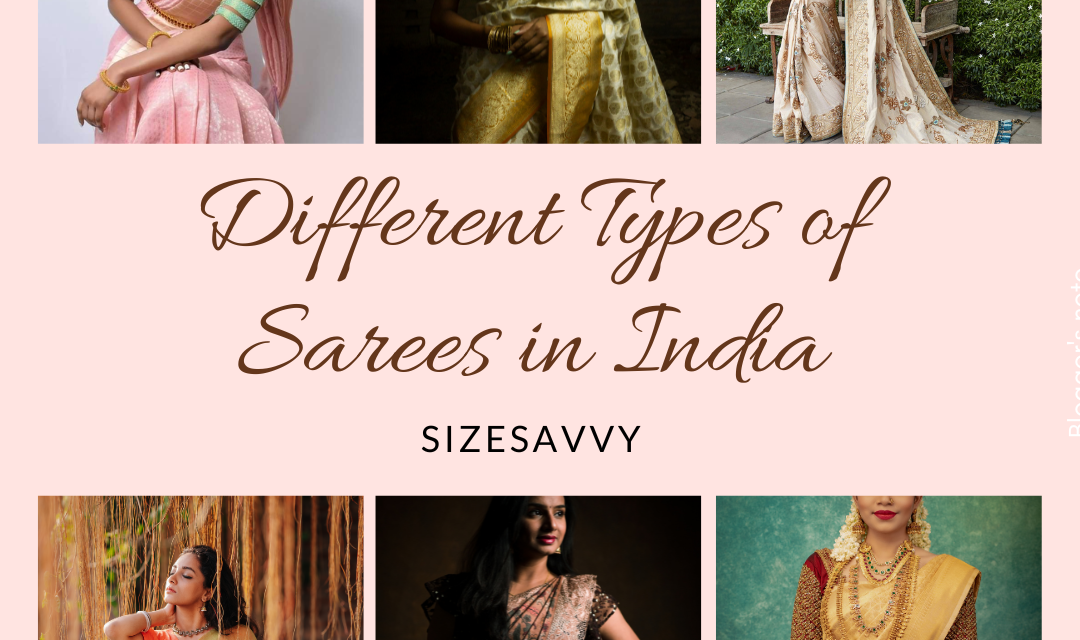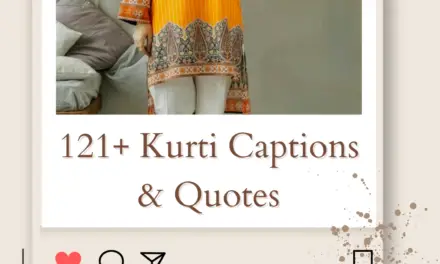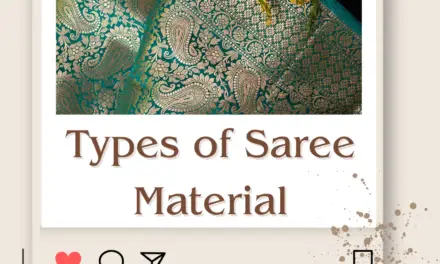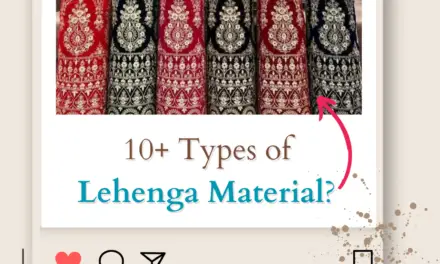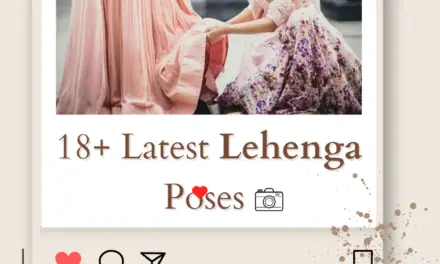What are the Types of Sarees in India? Sarees, the epitome of grace and elegance, have been a centuries-old attire in India. With their rich heritage and exquisite craftsmanship, sarees continue to captivate women of all ages.
From traditional classics to contemporary masterpieces, the world of sarees is vast and diverse. Note always prefer branded sarees because they offer all the below-listed sarees & know your saree size before selecting any saree.
In this list, you will learn about various sarees, highlighting their unique characteristics, origins, and occasions they are best suited for. So, let’s embark on a journey through the enchanting world of sarees. also, check for different types of blouses in India.
Different Types of Sarees and Key Features
| Saree Type | Origin | Key Features | Occasions |
|---|---|---|---|
| Banarasi Silk | Varanasi, Uttar Pradesh | Opulent silk, intricate zari work | Weddings and festive celebrations |
| Kanjeevaram Silk | Kanchipuram, Tamil Nadu | Heavy silk, vibrant colors, temple borders | Weddings and special occasions |
| Chanderi | Chanderi, Madhya Pradesh | Lightweight, sheer fabric, delicate zari work | Daytime events and casual wear |
| Tussar Silk | Various states | Raw silk texture, natural colors | Casual gatherings |
| Patola | Patan, Gujarat | Double ikat weave, vibrant geometric patterns | Weddings and special ceremonies |
| Paithani | Paithan, Maharashtra | Peacock motifs, vibrant colors, rich silk | Weddings and cultural events |
| Bandhani | Rajasthan and Gujarat | Tie-dye patterns, vibrant colors | Festivals and celebrations |
| Kasavu | Kerala | Creamy white with gold zari borders | Traditional Kerala events |
| Muga Silk | Assam | Golden silk, natural sheen, intricate motifs | Assamese weddings |
| Baluchari | West Bengal | Mythological stories on pallu, intricate borders | Cultural events and gatherings |
| Sambalpuri | Sambalpur, Odisha | Ikat patterns, traditional motifs, vibrant hues | Casual wear and regional celebrations |
| Kota Doria | Kota, Rajasthan | Lightweight, translucent fabric, delicate weave | Daytime functions and casual outings |
| Chikankari | Lucknow, Uttar Pradesh | Intricate white-on-white embroidery, ethereal elegance | Summer events and semi-formal gatherings |
| Gadwal | Gadwal, Telangana | Silk-cotton blend, large borders, contrasting pallu | Weddings and festive occasions |
| Kalamkari | Andhra Pradesh | Hand-painted or block-printed motifs, artistic | Cultural events and artistic gatherings |
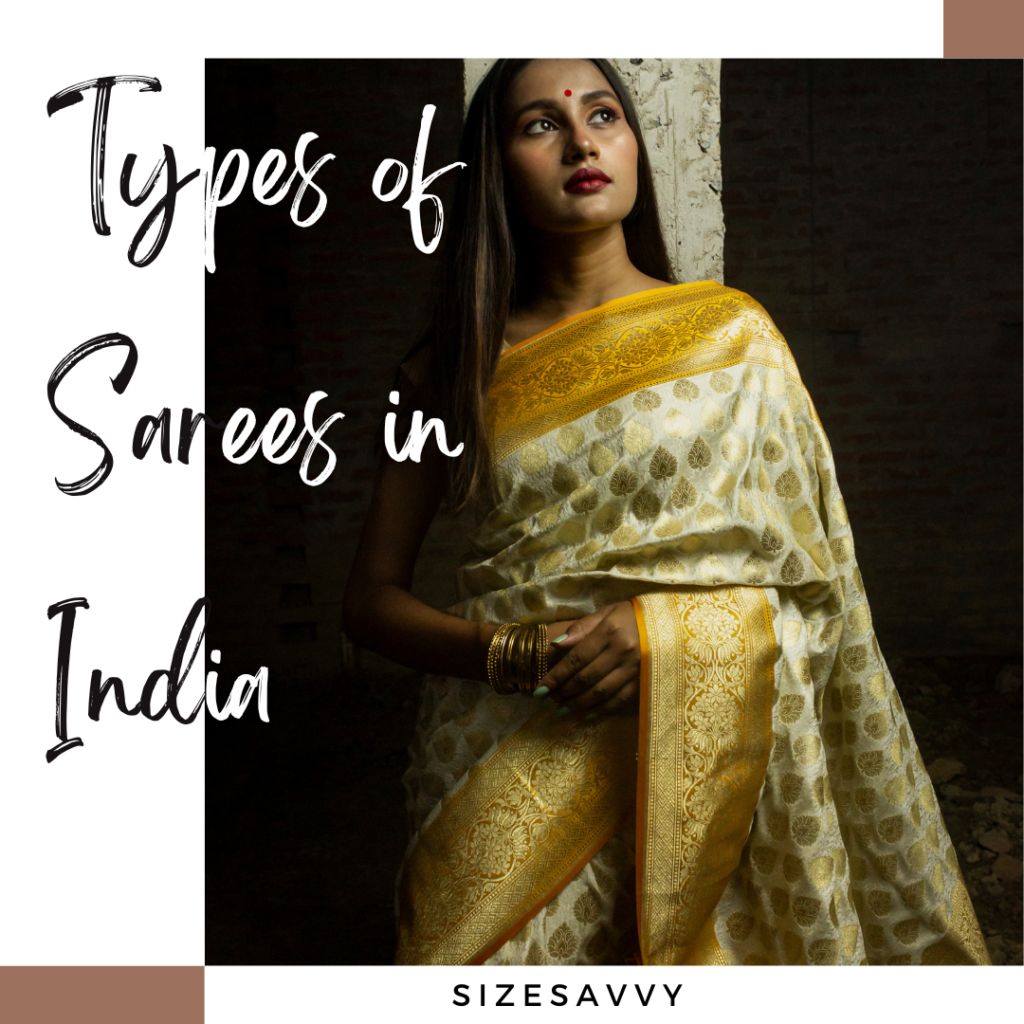
Banarasi Silk Saree from Uttar Pradesh
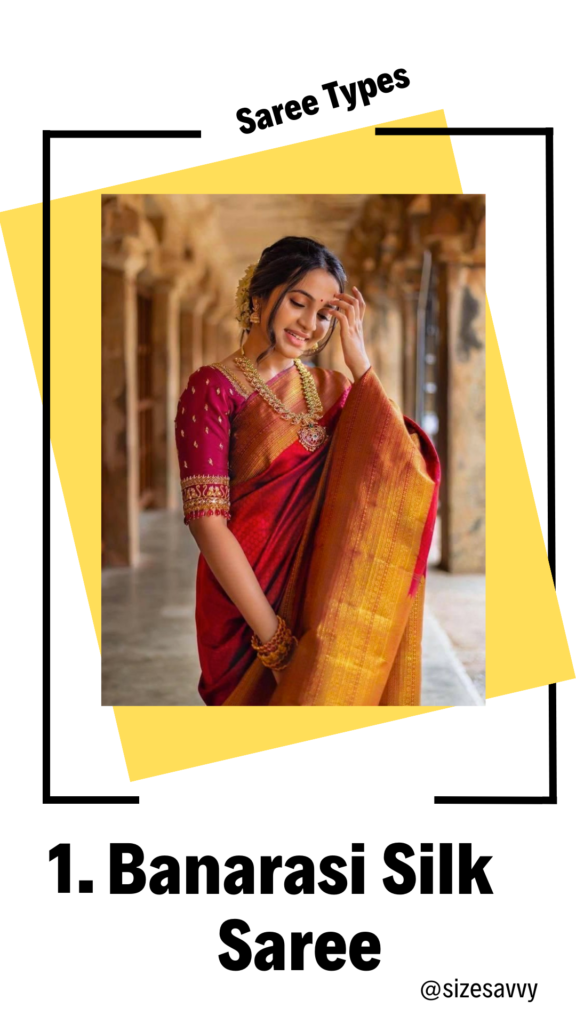
Origin: Varanasi, Uttar Pradesh
Key Features: Opulent silk, intricate zari work
Occasions: Weddings and festive celebrations
Banarasi sarees are renowned for their rich silk fabric and exquisite zari work. They are a symbol of luxury and elegance, making them a popular choice for weddings and special saree occasions.
Kanjeevaram Silk Saree from Tamil Nadu
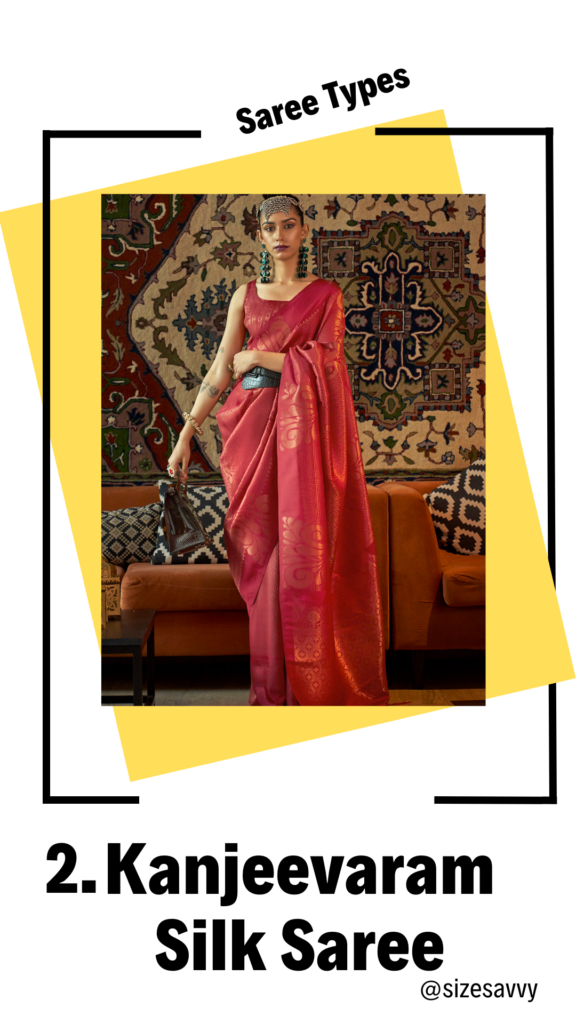
Origin: Kanchipuram, Tamil Nadu
Key Features: Heavy silk, vibrant colors, temple borders
Occasions: Weddings and special occasions
Kanjeevaram sarees are known for their vibrant colors and intricate temple border designs. They are a must-have for South Indian brides. the vibrant color of this saree make this ideal for all skin type.
Chanderi Saree from Madhya Pradesh
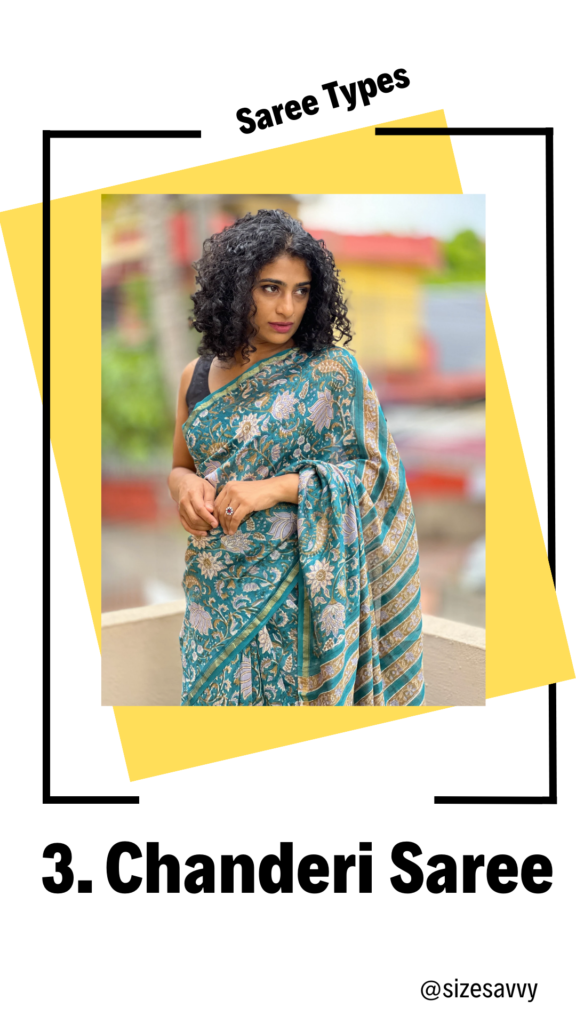
Origin: Chanderi, Madhya Pradesh
Key Features: Lightweight, sheer fabric, delicate zari work
Occasions: Daytime events and casual wear
Chanderi sarees are cherished for their sheer texture and delicate zari work. They are perfect for daytime gatherings and casual outings. they recommended pairing with Simple Aari Work Blouse Designs.
Tussar Silk Saree from Bengal
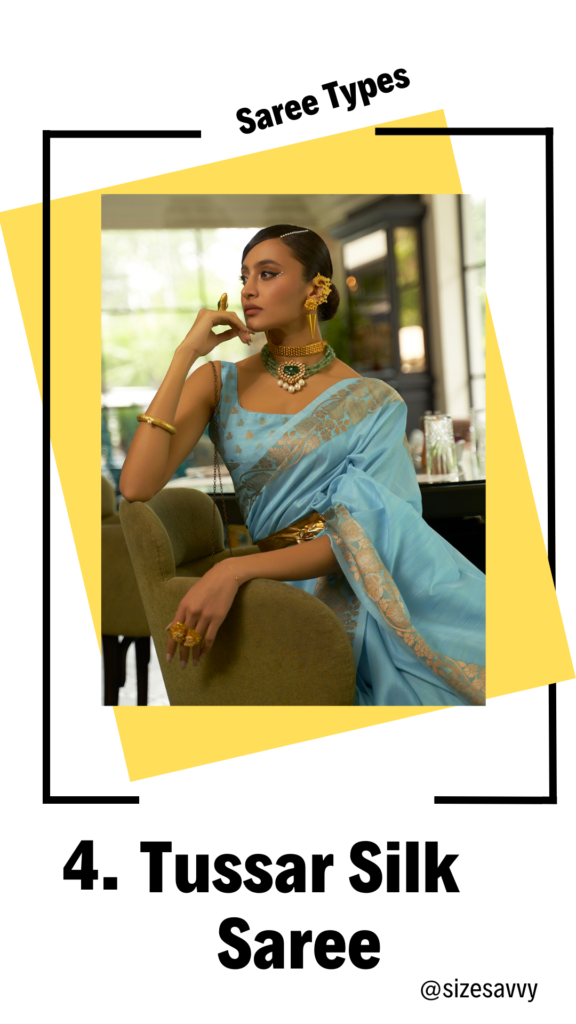
Origin: Various states
Key Features: Raw silk texture, natural colors
Occasions: Casual gatherings
Tussar silk sarees, known for their raw silk texture and earthy tones, are great for casual get-togethers and family occasions. tussar sarees are always paired with Silk Blouse Designs.
Patola Saree from Gujarat

Origin: Patan, Gujarat
Key Features: Double ikat weave, vibrant geometric patterns
Occasions: Weddings and special ceremonies
Patola sarees are a masterpiece of double ikat weaving, featuring stunning geometric patterns. They are a symbol of Gujarat’s rich textile heritage.
Paithani Saree from Maharashtra
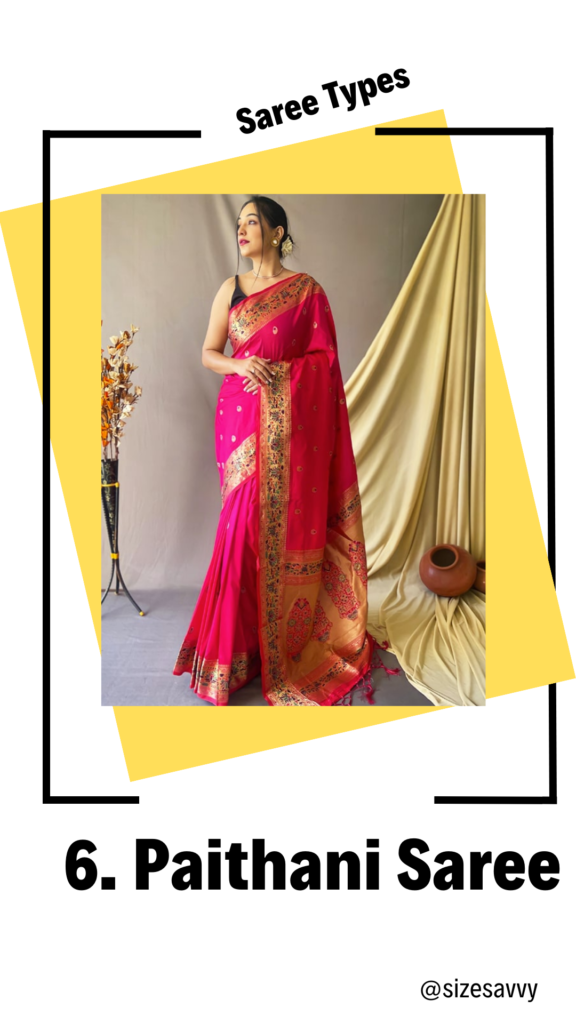
Origin: Paithan, Maharashtra
Key Features: Peacock motifs, vibrant colors, rich silk
Occasions: Weddings and cultural events
Paithani sarees are adorned with intricate peacock motifs and vibrant colors. They are a favorite choice for Maharashtrian brides. Paithani sarees come in a variety of color options make sure you pick the right saree color because most of them get confused with saree colors.
Bandhani Saree from Rajasthan
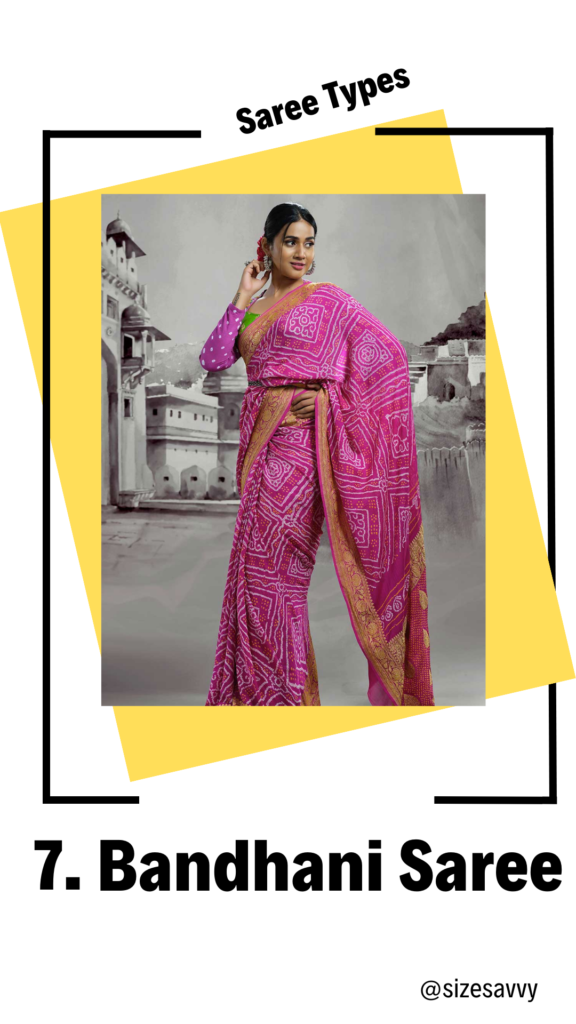
Origin: Rajasthan and Gujarat
Key Features: Tie-dye patterns, vibrant colors
Occasions: Festivals and celebrations
Bandhani sarees are known for their tie-dye patterns, which create a captivating visual appeal. They are popular during festivals and joyful occasions.
Kasavu Saree from Kerala
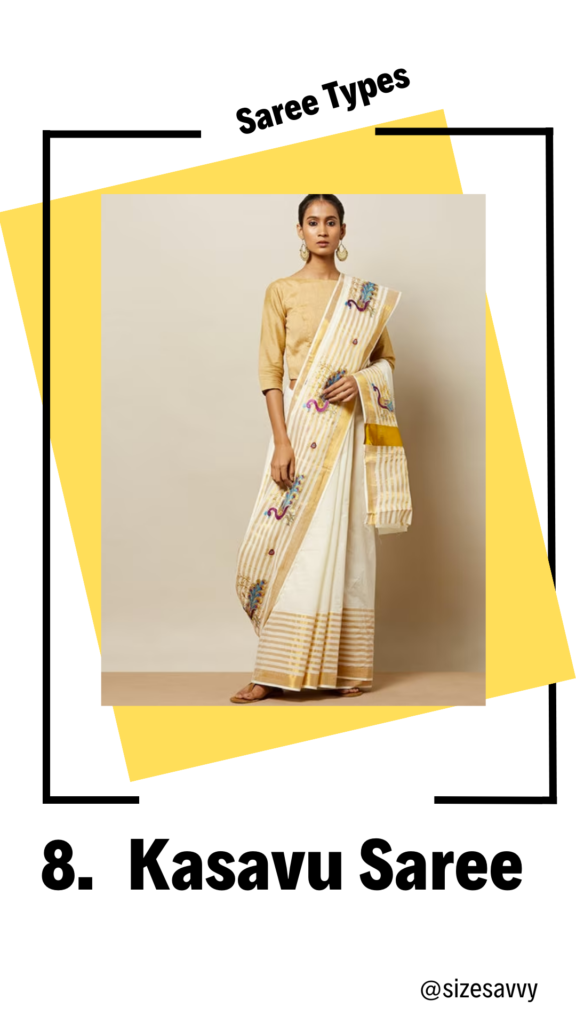
Origin: Kerala
Key Features: Creamy white with gold zari borders
Occasions: Traditional Kerala events
Kasavu sarees are the epitome of simplicity and elegance, with their creamy white base and intricate gold zari borders. They are a staple at Kerala’s traditional events. and don’t forget to match your hairstyle with this saree.
Muga Silk Saree from Assam
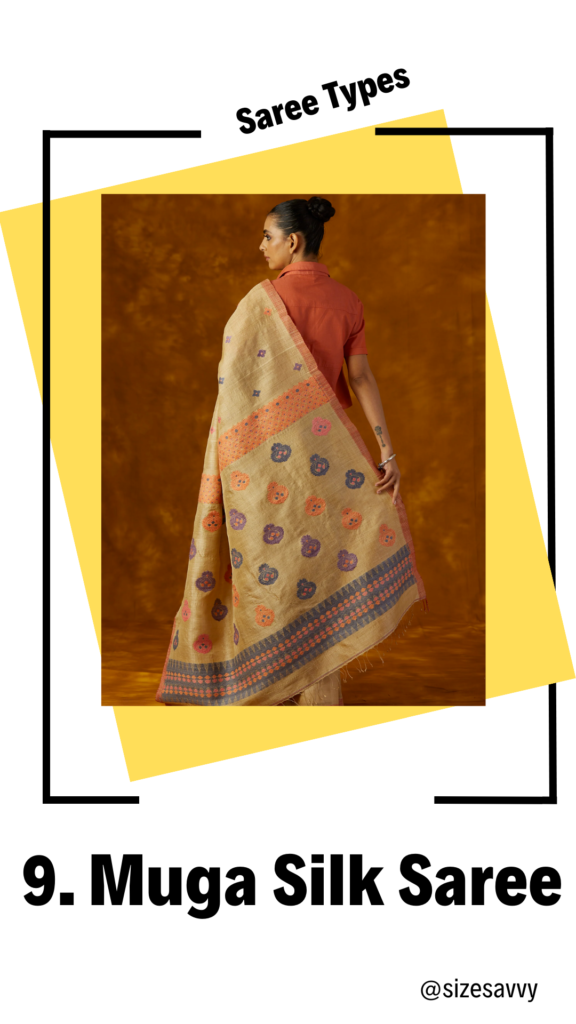
Origin: Assam
Key Features: Golden silk, natural sheen, intricate motifs
Occasions: Assamese weddings
Muga silk sarees, made from the golden silk of Assam, exude a natural sheen. They are treasured as bridal attire in Assamese weddings. this muga saree is paired with Pattu Saree Blouse Designs most of the time by models.
Baluchari Saree from West Bengal
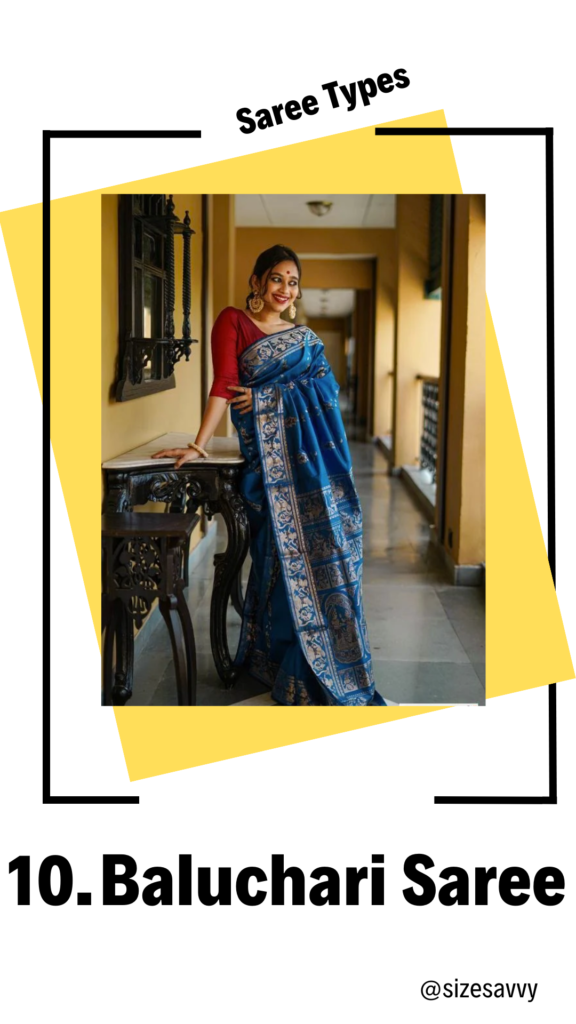
Origin: West Bengal
Key Features: Mythological stories on pallu, intricate borders
Occasions: Cultural events and gatherings
Baluchari sarees are known for depicting mythological stories on their pallu. They are perfect for cultural events and gatherings.
Sambalpuri Saree from Odisha
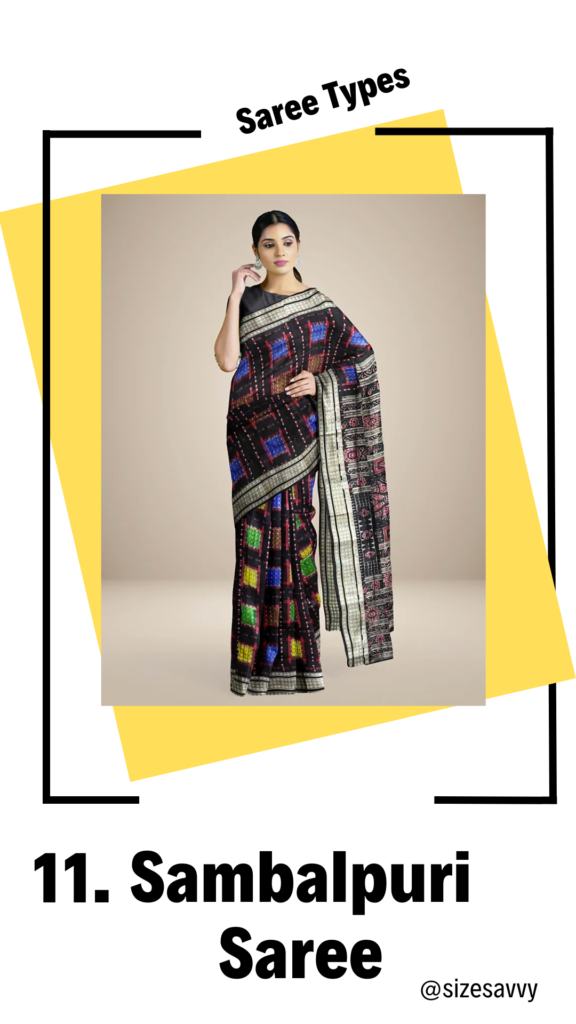
Origin: Sambalpur, Odisha
Key Features: Ikat patterns, traditional motifs, vibrant hues
Occasions: Casual wear and regional celebrations
Sambalpuri sarees are cherished for their ikat patterns and traditional motifs. They are ideal for casual wear saree and regional festivities.
Kota Doria Saree from Rajasthan
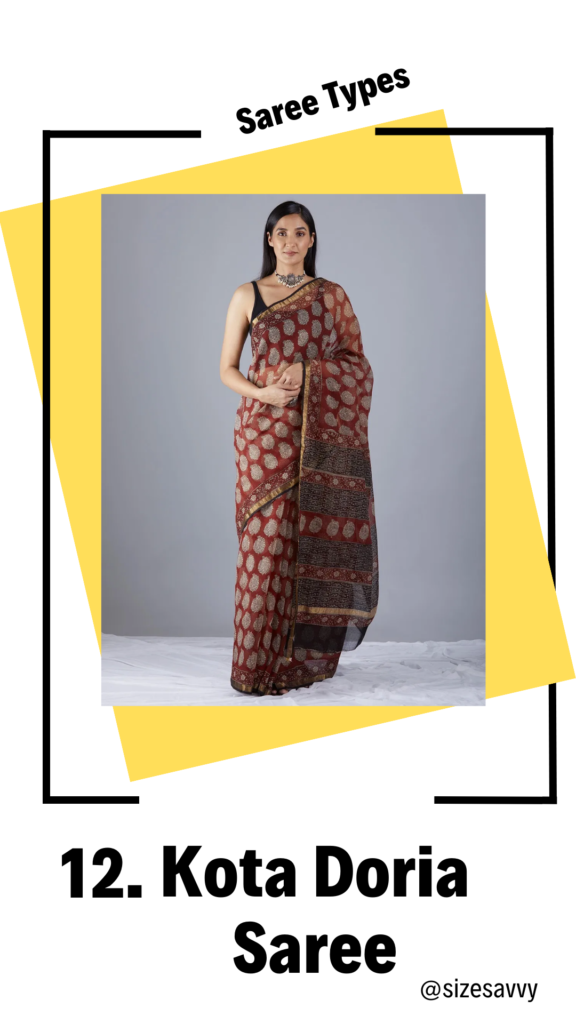
Origin: Kota, Rajasthan
Key Features: Lightweight, translucent fabric, delicate weave
Occasions: Daytime functions and casual outings
Kota Doria sarees are loved for their lightweight and translucent fabric, perfect for daytime functions and casual outings.
Chikankari Saree from Uttar Pradesh
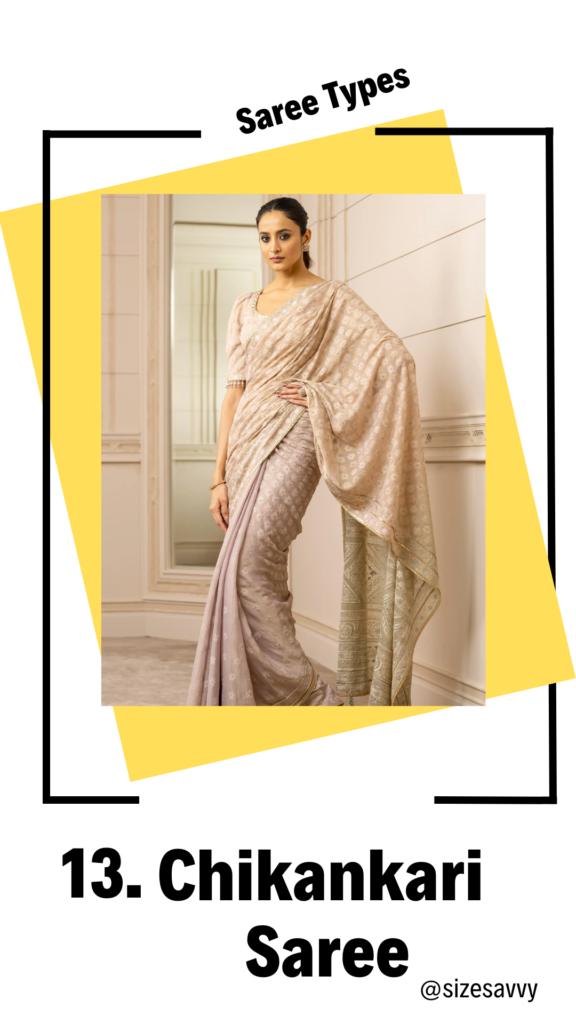
Origin: Lucknow, Uttar Pradesh
Key Features: Intricate white-on-white embroidery, ethereal elegance
Occasions: Summer events and semi-formal gatherings
Chikankari sarees feature intricate white-on-white embroidery, lending an ethereal elegance. They are an excellent choice for summer events. the important thing that you must know is how to Drape a Saree. because Chikankari sarees are so soft it may be tricky for beginners to wear a saree.
Gadwal Saree from Telangana
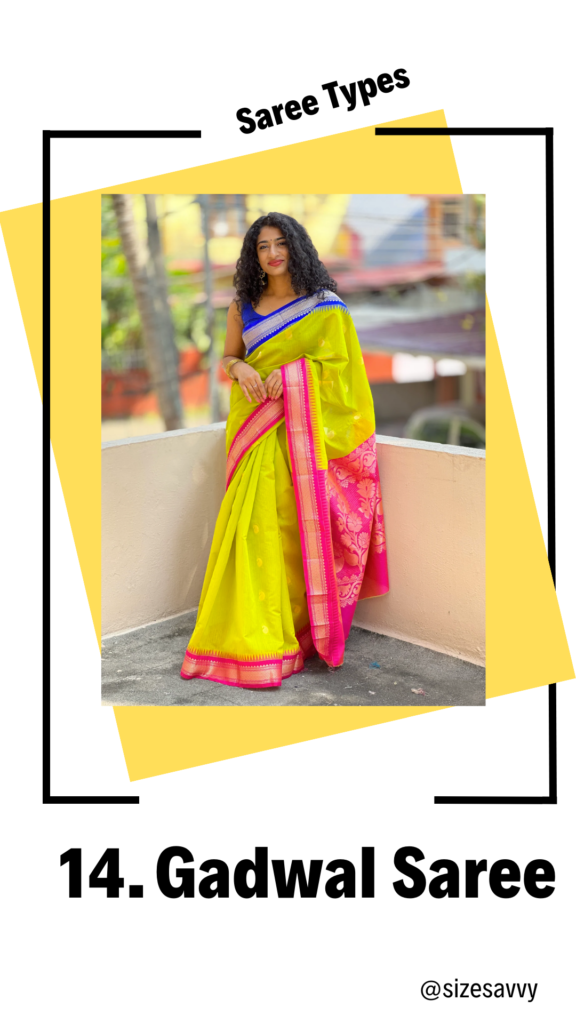
Origin: Gadwal, Telangana
Key Features: Silk-cotton blend, large borders, contrasting pallu
Occasions: Weddings and festive occasions
Gadwal sarees are crafted from a silk-cotton blend and are known for their large borders and contrasting pallu. They are a favorite at weddings and festive celebrations. These sarees make the best pairing with Cotton Saree Blouse Designs.
Takeaway I don’t prefer this Gadwal saree for Plus-size women, because the saree gets stiff when you drape it. which makes you look oversized when you wear a saree. or you can choose any best Saree Shapewear to make it compile.
Kalamkari Saree from Andhra Pradesh
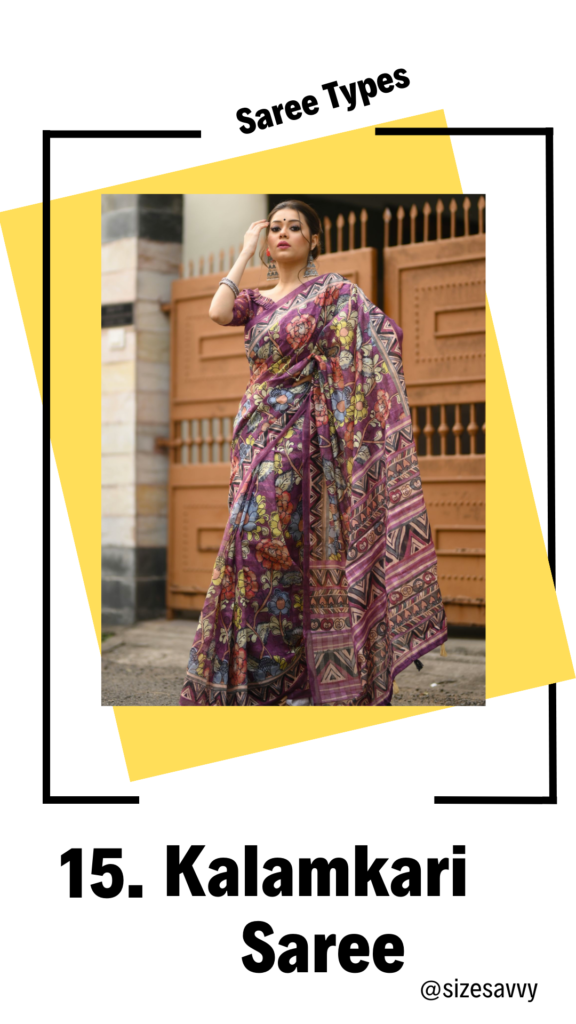
Origin: Andhra Pradesh
Key Features: Hand-painted or block-printed motifs, artistic
Occasions: Cultural events and artistic gatherings
Kalamkari sarees feature hand-painted or block-printed motifs, making them a canvas of artistry. They are perfect for cultural events and artistic gatherings. Note make sure to match your bra with any type of saree you prefer.
Sarees in Tamil Nadu
- Kanchipuram Silk: For weddings and special occasions.
- Madurai Cotton: Lightweight and vibrant for everyday wear.
- Chettinad Cotton: Features checks and stripes, suitable for various occasions.
- Kanjivaram Pattu: Opulent silk with intricate zari work.
- Coimbatore Cotton: Perfect for hot weather, simple yet elegant.
Sarees in Maharashtra
- Paithani: Exquisite silk with peacock motifs for weddings.
- Narayan Peth: Fine silk with delicate zari borders for special occasions.
- Lugade (Nauvari Saree): Traditional nine-yard drape for cultural events.
- Kolhapuri: Vibrant cotton sarees for daily wear.
Sarees in Karnataka
- Mysore Silk: Soft silk with intricate zari work for weddings.
- Ilkal: Unique pallu and traditional colors for cultural events.
- Kasuti Embroidery: Features Kasuti embroidery, ideal for artistic appeal.
- Molakalmuru Silk: Rich colors and fine silk for formal events.
Sarees in Andhra Pradesh
- Gadwal: Silk with contrasting borders, perfect for weddings.
- Uppada Silk: Lightweight silk with vibrant colors for various occasions.
- Pochampally Ikat: Unique tie-and-dye patterns, ideal for saree enthusiasts.
- Mangalagiri: Comfortable cotton sarees for daily wear.
- Dharmavaram Silk: Rich silk with intricate zari work for grand events.
Sarees in West Bengal
- Baluchari: Silk with narrative motifs for traditional events.
- Kantha Stitch: Features Kantha embroidery, suitable for casual occasions.
- Dhakai Jamdani: Lightweight muslin with intricate jamdani motifs for festivities.
- Tant: Fine cotton sarees for daily wear in hot weather.
- Garad: Silk with contrasting borders for traditional ceremonies.
Sarees in Odisha
- Sambalpuri: Unique tie-and-dye patterns for artistic appeal.
- Bomkai: Intricate threadwork and distinctive borders for formal events.
- Kotpad: Natural dyed fabric with tribal motifs, reflecting indigenous heritage.
- Berhampuri Silk: Silk with traditional motifs for weddings and celebrations.
- Khandua: Features temple motifs, worn during religious ceremonies and festivals.
How to Choose the Best Saree
- Occasion: Consider the event; silk for formal, georgette for casual.
- Body Type: Tailor your choice to flatter your physique.
- Saree Fabric: Cotton for comfort, silk for luxury, explore organza and linen.
- Color: Harmonize with your skin tone and event theme.
- Design: Opt for embroidery per occasion; heavy for grand events, minimal for casual outings.
- Blouse: Coordinate fabric and color; experiment with modern designs.
- Budget: Set a budget, and focus on quality within your range.
- Style: Choose between traditional weaves and contemporary drapes.
- Customization: Explore tailored options for a perfect fit.
- Comfort: Prioritize ease of wear; ensure you can move comfortably.
Remember, the best saree is one that aligns with your style,
Check out this Video on Saree Tpes:
FAQs on Types of Sarees
What are the most popular types of sarees?
Some of the most popular types of sarees include Banarasi silk, Kanjeevaram, Bandhani, Chanderi, Patola, and Tussar silk sarees. These sarees are highly cherished for their exquisite craftsmanship and unique characteristics.
Are there specific regional sarees in India?
Yes, sarees in India are often associated with specific regions and reflect the local weaving techniques, designs, and motifs. For example, Kanjeevaram sarees are from Kanchipuram in Tamil Nadu, Bandhani sarees are from Rajasthan and Gujarat, and Patola sarees are from Gujarat.
Can I mix and match saree styles?
Yes, you can experiment with mixing and matching saree styles to create your unique look. For example, you can pair a Banarasi silk blouse with a plain chiffon saree or combine a Bandhani saree with a contrasting blouse to add an interesting twist to your ensemble.
What are the popular saree names?
Numerous popular saree names are associated with a specific region or style. Some well-known saree names include Kanjeevaram silk saree, Banarasi silk saree, Chanderi saree, Paithani saree, and Bandhani saree, among others.
What is the name of a soft saree?
Several sarees are known for their soft and comfortable texture. Some soft sarees include Chiffon sarees, Georgette sarees, and Tussar silk sarees, valued for their lightweight and smooth feel.
Which sarees are the most famous?
Some of the most famous sarees in India include the Kanjeevaram silk saree from Tamil Nadu, the Banarasi silk saree from Varanasi, and the Paithani saree from Maharashtra, among others.
Which type of saree is the most attractive?
Traditional silk sarees like Kanjeevaram and Banarasi are often admired for their rich and elegant look. However, what’s considered attractive can vary widely.
How many types of sarees can we wear?
There are numerous types of sarees in India, varying by region, fabric, and weaving style. Some well-known types include Kanjeevaram, Banarasi, Chanderi, Paithani, Bandhani, and more.
Which type of saree is best?
The best saree depends on personal preference, occasion, and body type. For example, Kanjeevaram sarees are considered elegant for weddings, while cotton sarees are comfortable for daily wear.
Which sarees are most famous?
Some of the most famous sarees in India include the Kanjeevaram silk saree from Tamil Nadu, the Banarasi silk saree from Varanasi, and the Paithani silk saree from Maharashtra.
Which saree is costly?
Kanjeevaram silk sarees are often considered costly due to their intricate weaving and high-quality silk.
Which sarees are old famous?
Sarees like Banarasi silk and Kanjeevaram silk have been famous for centuries and continue to be highly regarded today.
Which type of saree is best for daily wear?
Lightweight sarees made of cotton or soft silk-like Georgette or Chiffon are best for daily wear due to their comfort and ease of draping.
Which saree is best for a wedding?
Bridal sarees like Kanjeevaram, Banarasi, and Paithani are popular choices for weddings due to their rich designs and traditional significance.
Which saree is the queen of sarees?
Kanjeevaram silk sarees are often referred to as the queen of sarees due to their exquisite craftsmanship and royal appeal.
Which saree looks slim?
Sarees with vertical patterns or slim borders can create a slimming effect. Dark colors and lightweight fabrics like Georgette can also give a slim appearance.
Which saree is difficult to wear?
Sarees with heavy embroidery, intricate work, or very stiff fabrics can be challenging to wear, especially for beginners. Examples include heavily embellished bridal sarees.
Which is the oldest saree in India?
The oldest surviving saree in India is the Gupta Saree dating back to the 6th century CE. It was discovered in an ancient archaeological site in Gujarat and is now housed in the Calico Museum of Textiles in Ahmedabad.

